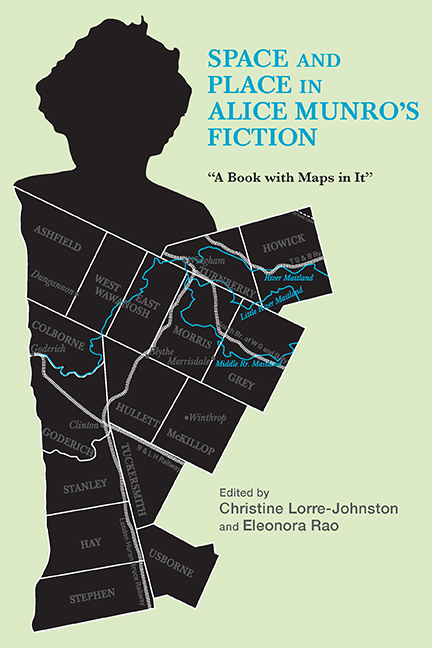Book contents
- Frontmatter
- Contents
- List of Illustrations
- Acknowledgments
- List of Abbreviations
- Introduction
- Part I Conceptualizing Space and Place: Houses, Landscapes, Territory
- Part II Close Readings of Space and Place
- 8 Spaces of Utopia and Spaces of Actuality in Alice Munro's “Jakarta”
- 9 Spatial Perspectives in Alice Munro's “Passion”
- 10 Charting Alice Munro's Terra Incognita: Punctuated Space in “Free Radicals”
- 11 Heterotopy in Alice Munro's “In Sight of the Lake”
- Bibliography
- Notes on the Contributors
- Index
10 - Charting Alice Munro's Terra Incognita: Punctuated Space in “Free Radicals”
from Part II - Close Readings of Space and Place
Published online by Cambridge University Press: 15 August 2018
- Frontmatter
- Contents
- List of Illustrations
- Acknowledgments
- List of Abbreviations
- Introduction
- Part I Conceptualizing Space and Place: Houses, Landscapes, Territory
- Part II Close Readings of Space and Place
- 8 Spaces of Utopia and Spaces of Actuality in Alice Munro's “Jakarta”
- 9 Spatial Perspectives in Alice Munro's “Passion”
- 10 Charting Alice Munro's Terra Incognita: Punctuated Space in “Free Radicals”
- 11 Heterotopy in Alice Munro's “In Sight of the Lake”
- Bibliography
- Notes on the Contributors
- Index
Summary
ALICE MUNRO's SHORT STORIES combine a comforting blend of familiar small-town hominess with an exploration of existential boredom or angst that is in fact the true dwelling place of many of her characters. Happiness is often a fragile hard-bargained-for state, jeopardized by wrong choices or fate. Munro's stories are no “sunshine sketches of a little town.” In fact, her story lines could often work as news briefs or titles of “true confessions”-type magazines. The story line of “Free Radicals,” from her collection Too Much Happiness for example, could read: “Butchers Handicapped Sister and Parents—Then Knocks at My Door!” The ordinariness of many of Munro's characters, the small-town Ontario that is the setting for many of her stories, and the seeming conversationality of her style all combine to veil her texts in a deceiving simplicity.
In “Free Radicals” Nita, the main character, has cancer. She has unexpectedly found herself a widow. This quirky little trick played upon her by fate is exacerbated when a stranger knocks on her door, supposedly to check the fuse box, and turns out to have just murdered his parents and mentally handicapped sister. The main part of the story recounts the time Nita and the stranger spend together. As the intruder becomes increasingly belligerent and drunk, the reader is made progressively uneasy as to the possibility of an even earlier death for Nita.
If herein we have the same ingredients found in a true confessions type of story, Munro, deftly pulling the narrative strings, has Nita do something that no true-confessions kind of protagonist is likely to venture to do. Aiming to protect herself from any erratic behavior from her visitor, Nita tells him a story in which she changes places with her husband's first wife, and portrays herself as the jealous wife who poisons the mistress with a rhubarb tart in order to prevent her husband from leaving her. Nita leads her captor to believe there is thus a shared complicity between them, enabling him to think that now that he knows this dark secret about her, he can make his getaway; she will never report the incident because he is in a position to report her crime.
- Type
- Chapter
- Information
- Space and Place in Alice Munro's Fiction“A Book with Maps in It”, pp. 183 - 198Publisher: Boydell & BrewerPrint publication year: 2018



